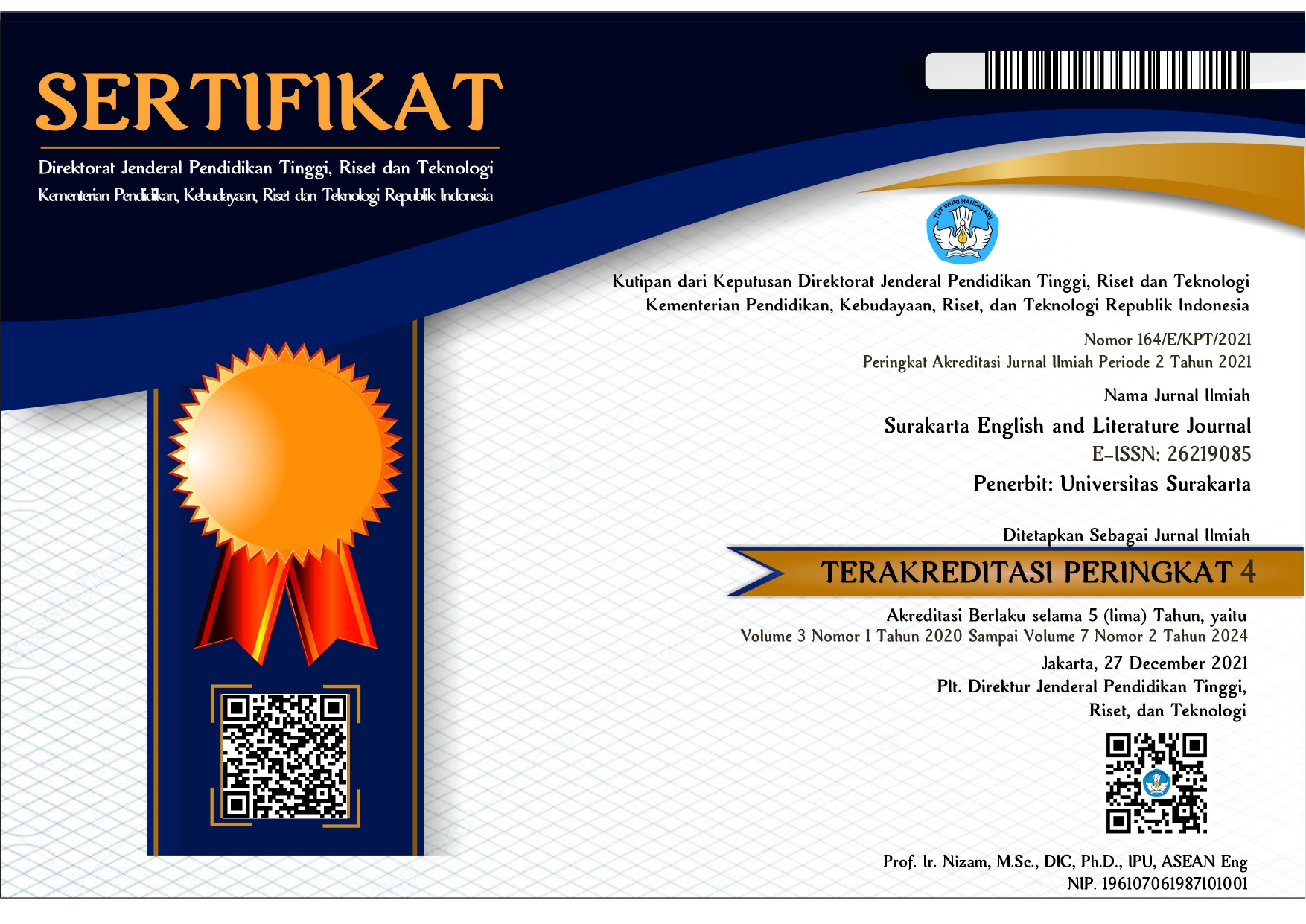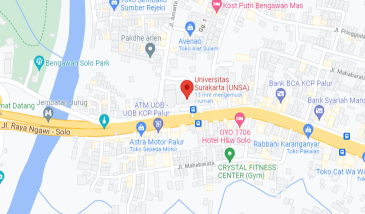Negative Politeness Strategy on Expressive Act of Rosiana Silalahi Talk Show
DOI:
https://doi.org/10.52429/selju.v5i2.26Keywords:
Expressive Act, Negative Politeness, Rosi Talk showAbstract
Rosi talk show was a conversation program that presented Indonesian politics with supporting and opposing government arguments. The objectives were to find expressive acts and to explain how expressive acts performed negative politeness in the Rosi talk show. The theories used politeness strategy by Brown and Levinson (1987) on negative politeness in expressive act by Searle (1975) by the moderator. This study used qualitative content analysis, and the location was YouTube Channel KompasTV. The data were the moderator utterances involving expressive acts representing negative politeness. This research was a purposive sampling technique focussing on three segments in ‘student’s demonstration and Ade Armando percussion’. The data collection technique was free to engage in conversation to transcribe data audio into written, and Focus Group Discussion (FGD) was used to know the moderator's politeness tendencies. This study used an interactive method by Miles&Huberman (1992) to conclude. The result showed 18 expressive acts with six sub-strategy of negative politeness. Then, seven expressive speech acts: thanking, apologising, blaming, praising, showing sympathy, and accusing. Next, the dominant moderators’ expressive act was blaming. While there are four sub-negative politeness strategies: indirect, making pessimism, minimising impositions, and apologising. The researcher found that negative politeness strategies were realised with expressive acts using suspecting to interact with pros participants.
References
Al-Khatib, M. A. (2021). (Im)politeness in Intercultural Email Communication between People of Different Cultural Backgrounds: A Case Study of Jordan and the USA. Journal of Intercultural Communication Research, 50(4), 409–430. https://doi.org/10.1080/17475759.2021.1913213
Award, P. (2007). Panasonic Awards 2007 (Issue November, pp. 1–6). https://p2k.unkris.ac.id/id3/1-3073-2962/2007_38576_p2k-unkris.html
Blaxter, et al. (2008). Bach, Shirley. 39(1), 181–192.
Blutner, R. (1989). Politeness: Some Universals in Language Usage. STUF - Language Typology and Universals, 42(1), 135–135. https://doi.org/10.1515/stuf-1989-0124
Dlali, M. (2001). Negative politeness and requests in isixhosa. South African Journal of African Languages, 21(3–4), 366–376. https://doi.org/10.1080/02572117.2001.10587485
Goffman, E. (1955). On Face-Work. Psychiatry, 18(3), 213–231. https://doi.org/10.1080/00332747.1955.11023008
Grice, P. (1975). 21. Grice (1975) - Logic and conversation.pdf. https://doi.org/doi:10.1016/j.pragma.2007.09.002
Juniawati, M. (2018). 40. Media Culture Radio Broadcast Dynamics in West Borneo. Proceedings of the 5th International Conference on Social and Political Sciences (IcoSaPS 2018), 241(IcoSaPS), 177–182. https://doi.org/10.2991/icosaps-18.2018.40
KompasTV, Y. C. (2022). 1 (p. 1). KompasTV. https://www.youtube.com/watch?v=j7gBiLk-6gM
Levinson, B. &. (1987). Online communication and students’ pragmatic choices in English. In Lodz Papers in Pragmatics (Vol. 9, Issue 1). https://doi.org/10.1515/lpp-2013-0005
Lofland. (2006). 済無No Title No Title No Title.
Moleong, L. J. (2018). Lexy J. Moleong, Metodologi Penelitian Kualitatif Edisi Revisi , Cetakan keduapuluh dua, Bandung: PT. Remaja Rosdakarya Offset, 2006, hal. 5. 2 Ibid., hal. 6. (Issue 1995).
Paputungan, R., Himpong, M., & Tekkay, A. (2017). Persepsi Masyarakat Tentang Talkshow “Mata Nadjwa” Di Metro Tv (Studi Pada Masyarakat Bahu Kecamatan Malalayang). Acta Diurna Komunikasi, 6(2), 1–17. https://ejournal.unsrat.ac.id/index.php/actadiurnakomunikasi/article/view/16567
Rijali, A. (2019). Analisis Data Kualitatif. Alhadharah: Jurnal Ilmu Dakwah, 17(33), 81. https://doi.org/10.18592/alhadharah.v17i33.2374
Santosa, R. (2021). Metodologi Penelitian Linguistik/ Pragmatik. Prosiding Prasasti, 0(0), 21–32. https://jurnal.uns.ac.id/prosidingprasasti/article/view/432
Saputry, D. (2016). Strategi Kesantunan Positif dan Negatif dalam Bentuk Tuturan Direktif di Lingkungan STKIP Muhammadiyah Pringsewu Lampung. Jurnal Pesona, 2(1), 149–160.
Searle, J. R. (2010). A taxonomy of illocutionary acts. Expression and Meaning, 1–29. https://doi.org/10.1017/cbo9780511609213.003
Siburian, A. (2016). An Analysis Of Politeness Strategy In Soimah Talkshow In TRANS TV. Episteme: Journal of Linguistics and Literature , 02(03), 1–13.
Sugiyono. (2018). Sugiyono Metode Penelitian Kuantitatif Kualitatif. Metode Penelitian Kuantitatif Kualitatif, 6.
Sutopo. (2006). Metode Penelitian Kualitatif. In UNS PRESS (1st ed., Vol. 53, Issue 9). UNS PRESS.
Utami, H. (2017). Strategi Kesantunan Negatif Pada Masyarakat Kampung Adat Cireundeu. Proceedings Education and Language International Conference, 1(1), 376–384. http://lppm-unissula.com/jurnal.unissula.ac.id/index.php/ELIC/article/viewFile/1251/959
Downloads
Published
How to Cite
Issue
Section
License
Copyright (c) 2022 Nurul Aini nurul, Djatmika, Sumarlam, Diah Kristina

This work is licensed under a Creative Commons Attribution-ShareAlike 4.0 International License.
Licensing for Data Publication
-
Open Data Commons Attribution License, http://www.opendatacommons.org/licenses/by/1.0/ (default)
-
Creative Commons CC-Zero Waiver, http://creativecommons.org/publicdomain/zero/1.0/
-
Open Data Commons Public Domain Dedication and Licence, http://www.opendatacommons.org/licenses/pddl/1-0/














